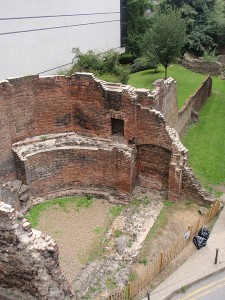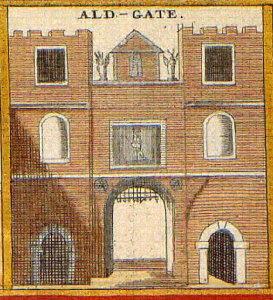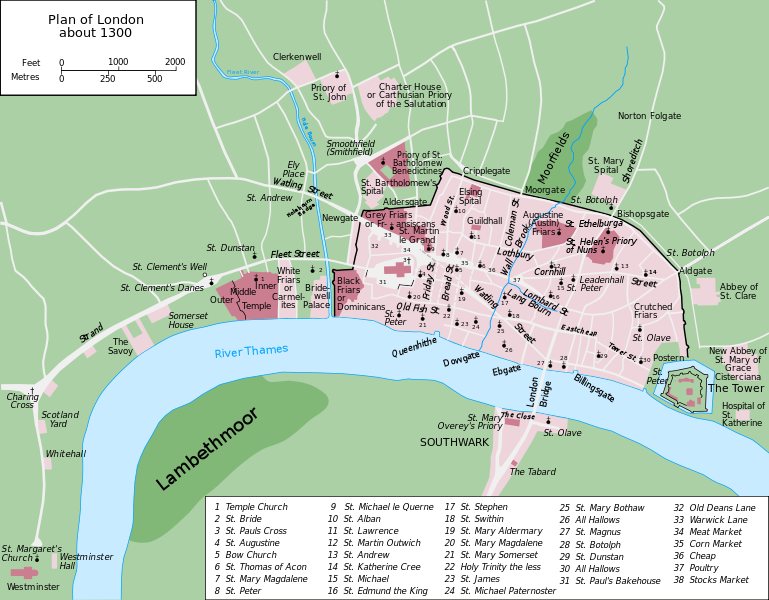Although Winchester was the Anglo-Saxon Royal City, by the time of Aethelred II’s reign in the late 10th century, London had become England’s financial and commercial powerhouse. There is so much to write about London that it cannot be done in a single blog post without making a reader’s eyes cross. So this post, and several that follow, will be a mix of journeys into the London that Emma of Normandy would have known in the early-to-mid-11th century. Let’s start with The Wall.
Aethelred’s London was surrounded by a mighty defensive wall that had been built by the Romans in the third century A.D. It was almost ten feet wide at its base, and it was twenty feet high. It had some seventy bastions that could hold catapults, an outer ditch that was six feet deep and, in some places, fifteen feet wide, and it had seven large gates.
Ludgate was on the west near St. Paul’s. The name Lud could be a reference to a pagan King Lud who founded the city before the Romans arrived; or it could derive from Flood or Fleet which enters the Thames to the west of the gate; or it could come from the Old English word hlid, meaning swing, which would translate to postern gate. Take your pick. The next gate is Newgate which led to Silchester. Then Aldersgate, named after a nearby grove, led to the village of Islington. Then we have Cripplegate. The name comes from the Old English word crepel, meaning a narrow passage, and this would indeed, along with Aldersgate, have been a narrower gate than the others. Bishopsgate was built across Ermine Street leading north to York. Aldgate was on the east and its name derived from the word ealth, meaning builder or owner. The last gate, Bridgegate, was on the far end of London Bridge, across the river.
There were several smaller gates through the wall, as well, meant for pedestrian use. One of these was on the eastern portion of the wall close to the River Thames, near where the Tower of London now stands.
The gates were closed at dusk and opened again at sunrise. Each gate would have been a toll point and a checkpoint. The gates themselves would not have been what we think of today as gates, but instead huge, wooden doors. They would have been fortified with a portcullis, and would have looked something like what you can see on the cover of my novel, Shadow on the Crown. Other major towns in 11th century England — Winchester, Canterbury, and Exeter, for example — would have had similar walls and gates.
Churches dedicated to St. Botolph stood just outside Aldgate, Bishopsgate and Aldersgate. St. Botolph was the patron saint of travelers, and one can imagine weary travelers arriving just past twilight, and bedding down in the church precincts until the gates opened in the morning.
London’s waterfront had a wall as well, although by Aethelred’s time it was quite possibly in very poor condition from the action of the Thames’ tidal waters. There were gates here, too, and officials to man them, for this was where merchant ships from far flung ports would unload their cargoes and pay whatever duties were owed to the king. London, within its ancient walls, became a financial powerhouse not through manufacturing, but through trade.
http://barryoneoff.co.uk/html/the_gates.html
Ackroyd, Peter. London: The Biography. Nan A. Talese, 2001.
Vince, Alan. Saxon London. Batsford, 1990.



I loved reading this and can’t wait for the others. :)
Welcome to the website, Leah. So great to know someone is reading!
Hi, Pat,
Congratulations on becoming an author! Mary Jane Freeland told me
about your literary career and new website. I just had to log in and applaud.
The news about me is that I have retired from the State of California and
moved to Carmel-by-the-Sea where I docent at the Carmel Mission and
volunteer in the library at the Carmel Foundation (the village’s Senior Citizen
Center). I would love to give you a tour of the Mission if you are ever in the
area.
Joanne Ablan
Joanne, it’s wonderful to hear from you! Congratulations on your retirement and on living in the little paradise of Carmel-by-the-Sea. And thank you for the applause. I’m so gratified that you took the time to check out the website and drop me a note. I hope that all my friends from all my past lives do that. Yes, whenever I make it down to Carmel, I’d love to have a tour of the mission.